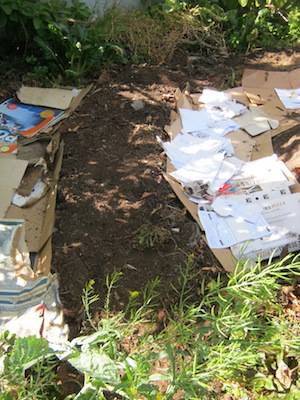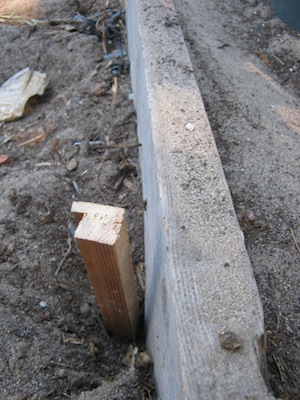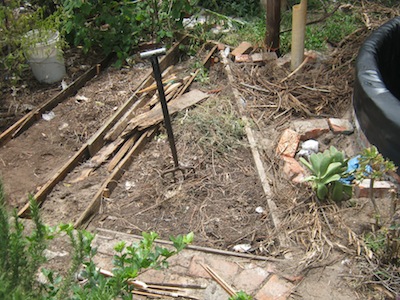Dear Reader, in this age of AI created content, please support with your goodwill someone who works harder to provide the human-made. Sign up at the top of the lefthand column or bottom of this page. You will receive my hand illustrated monthly newsletter RESTORE NATURE and access to the biodiversity garden design course as I write...and nothing else, I respect your time. I am also removing the advertizing as best I can as its become intrusive inappropriate and pays me nothing.
Bed preparation hacks album
This bed preparation hacks album follows on the article on bed preparation hacks, and shows four more beds prepared in a similar way, with cardboard or paper layers, to suppress weeds. This time they are sunken beds, not
merely laid on the ground over whatever was there. This means there was digging involved. Trenches were dug, lined with cardboard or phonebooks (smile) and refilled with sand and compost. The bed is made lower than the path by transferring much of the soil dug from the trenches in the beds into the paths. This necessitates strong stable edges, as we are essentially building raised paths rather than raised beds. The path in the first set was edged with loose bricks.
The cardboard is intended to hold water and add carbon, and the intention in sinking the beds is also to save water as we are threatened by another drought at the Cape this summer. I saw sunken beds by Guerilla House in Langa and Surrey in Cape Town, and I was told that they are damper than raised beds.
 The finished partly shaded south beds used to be raised
The finished partly shaded south beds used to be raisedThe next set of beds were edged with planks and stakes. I learned something here. The stakes will lean away from the sharp edge at the bottom as they are hammered into the ground. With maximum force they could not be righted. I pulled them up and turned the sharp edge of the wedge at the bottom at ninety degrees to the plank and this fixed the problem, providing better support. The deeper and stronger support of plank and stake edging allowed me to go much
deeper when digging out the beds. I got so involved I forgot to photograph the deep trenches lined with cardboard and waste paper. I'm hoping the deeper beds will be ideal for carrots. All the beds are semi shaded which is good in our climate. This bed is shaded from afternoon sun in the summer, and by buildings in the winter. We will see how they carrots and leaf vegetables do here. The other bed is hotter and I planted artichokes, asparagus, tamarillos and tomatoes, all grown from seed. I've written on easy to grow vegetables.
 The finished north beds, used to be a dessicated hugel beet notice old biddies can rip phonebooks when needed
The finished north beds, used to be a dessicated hugel beet notice old biddies can rip phonebooks when neededThe second bed is dug out, lined with paper and filled with compost and after settling in is ready for planting
------
home page for links to many useful pages on natural gardening and easy vegetable growing
------
bed preparation hacks learned in permaculture
You’re a home gardener ! Share your experiences and questions !
We all know about home gardening. Tell us about your successes, challenges and ask about issues that bother you. You may have the luxury of a back garden, but there are other ways we learn. Few people age without growing something or buying vegetables during their lives ! It is absolutely guaranteed that you have learned things which can help others on their gardening journey.
We invite you to share your stories, ask questions, because if a thing has bothered you it will bother others too. Someone may have a solution ! No question is too small. There is learning for everyone involved, for you, for me (yes, I learn from every question), for us all. Exciting stuff !
We are starting on a new journey. Every week we will profile your letters ! The best stories and questions we receive.
What Other Visitors Have Said
Click below to see contributions from other visitors to this page...
sunk beds 




This seems like ages ago. the Bok Choi is still going strong, so is the chard. but as everywhere else I struggle with root vegetables like onions. I've …
Restore Nature Newsletter
I've been writing for four years now and I would love to hear from you
Please let me know if you have any questions, comments or stories to share on gardening, permaculture, regenerative agriculture, food forests, natural gardening, do nothing gardening, observations about pests and diseases, foraging, dealing with and using weeds constructively, composting and going offgrid.
SEARCH
Order the Kindle E-book for the SPECIAL PRICE of only
Prices valid till 30.09.2023
Recent Articles
-
garden for life is a blog about saving the earth one garden at a time
Apr 18, 25 01:18 PM
The garden for life blog has short articles on gardening for biodiversity with native plants and regenerating soil for climate amelioration and nutritious food -
Cape Flats Sand Fynbos, Cape Town's most endangered native vegetation!
Apr 18, 25 10:36 AM
Cape Flats Sand Fynbos, a vegetation type found in the super diverse Cape Fynbos region is threatened by Cape Town's urban development and invasive alien plants -
Geography Research Task
Jan 31, 25 11:37 PM
To whom it may concern My name is Tanyaradzwa Madziwa and I am a matric student at Springfield Convent School. As part of our geography syllabus for this
"How to start a profitable worm business on a shoestring budget
Order a printed copy from "Amazon" at the SPECIAL PRICE of only
or a digital version from the "Kindle" store at the SPECIAL PRICE of only
Prices valid till 30.09.2023























